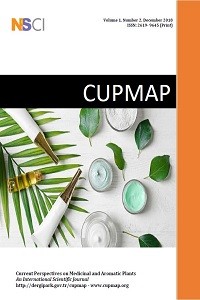Abstract
This study was designed to investigate antimicrobial properties of
natural essential oils including; citronella, cinnamon, palmarosa, niaouli,
clove, lavender, bergamot, lemon, grapefruit, petitgrain, peppermint, tea tree
and eucalyptus from different oil sources. Datas taken from the disk diffusion
assay indicate that cinnamon, niaouli, lavender, petitgrain and the tea tree
oils have the most intense antibacterial effects on related microorganisms at
the concentration %100 (direct usage). Endpoints confirm results reported in
the past studies including the MIC assays on the related natural oils. Overall,
natural oils have been used safely for many decades on the cosmetic
formulations and this experiment emphasizes one more time the importance of the
natural oils usage in industry
References
- 1. Hammer, K. A., Carson, C. F., 1999. Antimicrobial activity of essential oils and other plant extracts. J Appl Microbiol, Jun;86(6):985-90.
- 2. Wei A., Shibamoto T., 2010. Antioxidant/lipoxygenase inhibitory activities and chemical compositions of selected essential oils. J. Agric. Food Chem., 58 (12), 7218–7225.
- 3. Boyle, W., 1955. Spices and essential oils as presservatives. American Perfumer and Essential Oil Review, 66: 25-28.
- 4. Nychas, G.J.E., 1995. Natural antimicrobial from plants. New Methods of Food Preservation, Blackie Academic and Professional, London, 58-89.
- 5. Shelef, L. A., 1984. Antimicrobial Effects Of Spices. Antimicrobial Effects in Foods at the 83rd Annual Meeting of the American Society for Microbiology, New Orleans, March 6–11.
- 6. Gould, G. W., 1996. Industry perspectives on the use of natural antimicrobials and inhibitors for food applications. J Food Prot., 59(13):82-86.
- 7. Lis-Balchin M., Deans, S.G., 1997. Bioactivity of selected plant essential oils against Listeria monocytogenes. J. Appl. Microbiol., Jun; 82(6):759-62.
- 8. Santos, B., Corrêa, M., 2015. Sustainability, natural and organic cosmetics: consumer, products, efficacy, toxicological and regulatory considerations. Braz. J. Pharm. Sci. vol.51 no.1.
- 9. Markham, J., 1999. Biological activity of tea tree oil.
- 10. Ibukun A., Toyin A., 2006. Evaluation of the Antimicrobial Properties of Different Parts of Citrus Aurantifolia (Lime Fruit) as Used Locally.
- 11. K. A. Hammer C. F. Carson T. V. Riley ‘Antimicrobial activity of essential oils and other plant extracts’, 1999. Afr J Tradit Complement Altern Med. 2007; 4(2): 185–190.
- 12. Deans, S.G. 1987. Antibacterial properties of plant essential oils. International Journal of Food Microbiology, 5(2): 165-180.
- 13. Seyed F.N., Arianna D.L., Morteza I., 2015. Antibacterial Effects of Cinnamon: From Farm to Food, Cosmetic and Pharmaceutical Industries. Nutrients, 7(9): 7729–7748.
- 14. Koulivand, P., Ghadiri, M., Gör, A., 2003.Lavender and the Nervous System. Evidence-based Complementary and Alternative Medicine, 2013:681304.
Abstract
References
- 1. Hammer, K. A., Carson, C. F., 1999. Antimicrobial activity of essential oils and other plant extracts. J Appl Microbiol, Jun;86(6):985-90.
- 2. Wei A., Shibamoto T., 2010. Antioxidant/lipoxygenase inhibitory activities and chemical compositions of selected essential oils. J. Agric. Food Chem., 58 (12), 7218–7225.
- 3. Boyle, W., 1955. Spices and essential oils as presservatives. American Perfumer and Essential Oil Review, 66: 25-28.
- 4. Nychas, G.J.E., 1995. Natural antimicrobial from plants. New Methods of Food Preservation, Blackie Academic and Professional, London, 58-89.
- 5. Shelef, L. A., 1984. Antimicrobial Effects Of Spices. Antimicrobial Effects in Foods at the 83rd Annual Meeting of the American Society for Microbiology, New Orleans, March 6–11.
- 6. Gould, G. W., 1996. Industry perspectives on the use of natural antimicrobials and inhibitors for food applications. J Food Prot., 59(13):82-86.
- 7. Lis-Balchin M., Deans, S.G., 1997. Bioactivity of selected plant essential oils against Listeria monocytogenes. J. Appl. Microbiol., Jun; 82(6):759-62.
- 8. Santos, B., Corrêa, M., 2015. Sustainability, natural and organic cosmetics: consumer, products, efficacy, toxicological and regulatory considerations. Braz. J. Pharm. Sci. vol.51 no.1.
- 9. Markham, J., 1999. Biological activity of tea tree oil.
- 10. Ibukun A., Toyin A., 2006. Evaluation of the Antimicrobial Properties of Different Parts of Citrus Aurantifolia (Lime Fruit) as Used Locally.
- 11. K. A. Hammer C. F. Carson T. V. Riley ‘Antimicrobial activity of essential oils and other plant extracts’, 1999. Afr J Tradit Complement Altern Med. 2007; 4(2): 185–190.
- 12. Deans, S.G. 1987. Antibacterial properties of plant essential oils. International Journal of Food Microbiology, 5(2): 165-180.
- 13. Seyed F.N., Arianna D.L., Morteza I., 2015. Antibacterial Effects of Cinnamon: From Farm to Food, Cosmetic and Pharmaceutical Industries. Nutrients, 7(9): 7729–7748.
- 14. Koulivand, P., Ghadiri, M., Gör, A., 2003.Lavender and the Nervous System. Evidence-based Complementary and Alternative Medicine, 2013:681304.
Details
| Primary Language | English |
|---|---|
| Journal Section | Research Articles |
| Authors | |
| Publication Date | December 31, 2018 |
| Published in Issue | Year 2018 Volume: 1 Issue: 2 |
-------------------------------------------------------------------------------------------------------------------------------













-------------------------------------------------------------------------------------------------------------------------
 CUPMAP Journal is licensed under a Creative Commons Attribution-NonCommercial-NoDerivatives 4.0 International License.
CUPMAP Journal is licensed under a Creative Commons Attribution-NonCommercial-NoDerivatives 4.0 International License.
-----------------------------------------------------------------------------------------------------------------------------------------
This is an open access journal which means that all content is freely available without charge to the user or his/her institution. Users are allowed to read, download, copy, distribute, print, search, or link to the full texts of the articles, or use them for any other lawful purpose, without asking prior permission from the publisher or the author. This is in accordance with the BOAI definition of open access.

